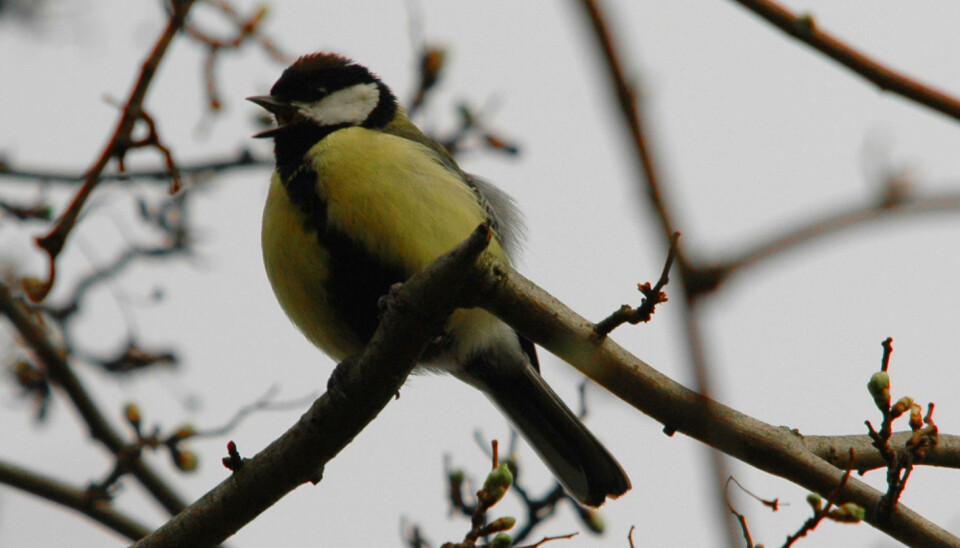
Urban design makes birds hit the high C
Birds raise their pitch to drown out traffic noise and to make themselves understood in the urban landscape.
Some years ago it was noted that city birds sing louder and at a higher frequency than birds in the countryside.
Up to now, researchers have disagreed about whether the birds increase the pitch of their song because they want to stand out from the low-frequency noise from traffic, machines and human activity, or whether the raising of their voices results in a distortion which causes the high pitch.
Now Danish and Welsh researchers point out a third option: high-frequency chirping helps the birds penetrate the architectural design of cities and makes it easier for them to communicate with one another.
“We have found that high-pitched chirping of birds is more understandable when the sound travels around between the city’s houses, walls, road, etc,” says Professor Torben Dabelsteen, of the Department of Biology at the University of Copenhagen, who conducted the study together with researchers from the University of Aberystwyth, Wales.
We just need to look at our own behaviour. When we raise our voices, the pitch tends to go up. We see the same behaviour in blackbirds. It’s entirely likely that they raise their pitch to evade traffic noise. But that fails to explain why birds also engage in high-pitched singing at night, when there is little traffic noise.
“I believe all three theories play a part in the explanation,” he adds.
Birds also hit the high C at night
It has long been known that traffic noise makes birds such as sparrows, blackbirds and the great tit sing louder or at a higher pitch. However, the two traditional theories for this phenomenon do not provide a complete explanation.
“We just need to look at our own behaviour. When we raise our voices, the pitch tends to go up,” he explains.
“We see the same behaviour in blackbirds. It’s entirely likely that they raise their pitch to evade traffic noise. But that fails to explain why birds also engage in high-pitched singing at night, when there is little traffic noise.”
Architecture plays a part
The new study shows that the high frequencies are better at penetrating the surface area in a city landscape with all its houses and walls that throw back the sound waves.
In urban areas it is usually easy for the birds to see their fellow species, so they don’t need to locate one another through song. Here it probably makes sense for the birds to use high-pitched chirps as the high notes don’t produce many echoes on their way through the various surfaces of the city landscape. That way, the sound is clearer when it reaches its destination.
In woodlands, however, trees and bushes can make it hard for the birds to see their fellow species. Here they tend to use lower frequencies to locate one another and to find out if singing rivals have intruded on their territory.
In addition, the echoes in the woods are useful for judging distances, and there’s no traffic noise to combat.
“Our previous studies have shown that birds generally use the strength of echoes and degradation in the chirps to measure the distance between themselves and other birds,” says Dabelsteen.
Comparing urban and rural bird song
By recording the chirps of urban great tits and rural great tits and playing back both types in city and woodland areas, the researchers were able to determine whether the high-pitched song registered more clearly in cities than in woodlands.
The team placed speakers and microphones in locations where the birds were frequently observed singing.
They then analysed the amount and the persistence of echoes, the degree of degradation and how the chirps died out.
City chirps are clearer
It turned out that urban great tit song travelled significantly better through the urban landscape – and in some cases, woodlands too.
“It’s got something to do with reflective surfaces,” says the researcher.
“We noticed that the echoes died out faster in high-pitched city chirps than in woodland chirps.”
This means that in cities there are fewer echoes to disrupt the message of the song.
Other studies have indicated that birds can be flexible and adapt their song to their environment, so that the song doesn’t get too high-pitched when they visit rural areas or when the noise in the city has died down at night.
--------------------------------------------------
Read the article in Danish at videnskab.dk
Translated by: Dann Vinther








